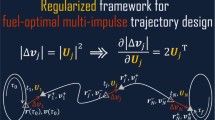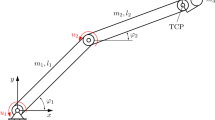Abstract
The dynamic problem of the rotation of a rigid body (for example, a spacecraft) from an arbitrary initial to the required final angular position in the presence of control restrictions is considered and solved. The end time of the maneuver is known. To optimize the rotation control program, a quadratic quality criterion is used, the minimized functional characterizes energy costs. The construction of optimal turn control is based on quaternion variables and the L. S. Pontryagin maximum principle. The features of optimal motion are studied in detail. Key properties of the optimal solution are formulated in an analytical form. It is shown that in the case of limited control, the moment of forces in the process of optimal rotation is parallel to a straight line that is stationary in inertial space, and during rotation of a rigid body (spacecraft) the direction of the kinetic moment is constant relative to the inertial coordinate system. Optimal control is presented in the form of synthesis—the synthesizing function is found and the dependence of the control variables on the phase coordinates is given. Formalized equations and calculation expressions are obtained to determine the optimal rotation program. The constructive scheme for solving the boundary value problem of the maximum principle for arbitrary rotation conditions (initial and final positions and moments of inertia of a solid body) is also described. An example and results of mathematical modeling of the motion of a spacecraft as a solid with optimal control are presented, demonstrating the practical feasibility of the developed method for controlling the spatial orientation of the spacecraft. For a dynamically symmetric solid, a complete solution of the reorientation problem in closed form is given, control variables and the optimal trajectory of motion as functions of time are presented in an analytical form.
Similar content being viewed by others
References
K. B. Alekseev, and G. G. Babenin, Spacecraft Control (Mashinostroenie, Moscow, 1974) [in Russian].
N. E. Zubov, “Optimal Control of the Spacecraft Terminal Retargeting on the Basis of the Predictive Model Algorithm,” Kosm. Issl. 29(3), 340–351 (1991).
A. I. Van’kov, “Spacecraft AngularMotion Adaptive Robust Control Based on the Use of Predictive Models,” Kosm. Issl. 32(4-5), 13–21 (1994).
O. V. Ermoshina, and A. P. Krishchenko, “Synthesis of Programmed Controls of Spacecraft Orientation by the Method of Inverse Problem of Dynamics,” Izv. Akad. Nauk. Teor. Sist. Upr. No. 2, 155–162 (2000) [J. Comp. Sys. Sci. Int. (Engl. Transl.) 39(2), 313–320 (2000)].
M. V. Levskii, “Pontryagin’s Maximum Principle in Optimal Control Problems of Orientation of a Spacecraft,” Izv Akad. Nauk. Teor. Sist. Upr. No. 6, 144–157 (2008) [J. Comp. Sys. Sci. Int. (Engl. Transl.) 47 (6), 974–986 (2008)].
S. Liu, and T. Singh, “Fuel/Time Optimal Control of Spacecraft Maneuvers,” J. Guid. 20(2), 394–397 (1996).
S. Scrivener, and R. Thompson, “Survey of Time-Optimal Attitude Maneuver,” J. Guid. Cont. Dyn. 17(2), 225–233 (1994).
V.N. Branets, and I.P. Shmyglevskii, Application of Quaternions to Rigid Body Attitude Problems (Nauka, Moscow, 1973) [in Russian].
V. N. Branets, M. B. Chertok, and Yu. V. Kaznacheev, “Optimal Turn of a Rigid Body with a Single Axis of Symmetry,” Kosm. Issl. 22(3), 352–360 (1984) [Cosmic Res. (Engl. Transl.)].
H. Shen, and P. Tsiotras, “Time-Optimal Control of Axi-Symmetric Rigid Spacecraft with Two Controls,” AIAA J. Guid. Cont. Dyn. 22(5), 682–694(1999).
A. V. Molodenkov, and Ya. G. Sapunkov, “A Solution of the Optimal Turn Problem of an Axially Symmetric Spacecraft with Bounded and Pulse Control Under Arbitrary Boundary Conditions,” Izv. Akad. Nauk. Teor. Sist. Upr. No. 2, 90–105 (2007) [J. Comp. Sys. Sci. Int. (Engl. Transl.) 46 (2), 310–323 (2007)].
F. Li, and P.M. Bainum, “Numerical Approach for Solving Rigid Spacecraft Minimum Time Attitude Maneuvers,” J. Guid. Cont. Dyn. 13(1), 38–45(1990).
A. A. Krasovskii, Systems of Flight Automatic Control and Their Analytic Design (Nauka, Moscow, 1973) [in Russian].
B. V. Raushenbakh, and E. N. Tokar’, Control of Spacecraft Attitude (Nauka, Moscow, 1974) [in Russian].
J. L. Junkins, and J. D. Turner, Optimal Spacecraft Rotational Maneuvers (Elsevier, 1986).
R. Byers, and S. Vadali, “Quasi-Closed-Form Solution to the Time-Optimal Rigid Spacecraft Reorientation Problem,” AIAA J. Guid. Cont. Dyn. 16(3) 453–461 (1993).
M. V. Levskii, “Control of Spacecraft Spatial Turn with Minimal Value of the Way Functional,” Act. Prob. Avia. Aero. Sys. 14(1), 81–94 (2009).
M. V. Levskii, “Use of the Energy Integral in Optimal Control of the Spacecraft Spatial Attitude,” Izv. Ros. Akad. Nauk. Mekh. Tv. Tela, No. 2, 7–24 (2009) [Mech. Sol. (Engl. Trans.) 44 (4), 502–513 (2009)].
A. V. Molodenkov, and Ya. G. Sapunkov, “A New Class of Analytic Solutions in the Optimal Turn Problem for a Spherically Symmetric Body,” Izv. Ros. Akad. Nauk. Mekh. Tv. Tela, No. 2, 16–27 (2012) [Mech. Sol. (Engl. Trans.) 47(2), 167–177 (2012)].
Reference Book on the Automatic Control Theory, Ed. by A. A. Krasovskii (Nauka, Moscow, 1987) [in Russian].
L. S. Pontryagin, V. G. Boltyanskii, R. V. Gamkrelidze, and E. F. Mishchenko, The Mathematical Theory of Optimal Processes (Wiley-Interscienc, New York, 1962; Nauka, Moscow, 1983).
G. Lastman, “A shooting Method for Solving Two-Point Boundary-Value Problems Arising from Nonsingu-lar Bang-Bang Optimal Control Problems,” Int. J. Contr 27(4), 513–524. (1978)
E. Bertolazzi, F. Biral, and M. Da Lio, “Symbolic-Numeric Efficient Solution of Optimal Control Problems forMultibody Systems,” J. Comput. Appl. Math. 185(2), 404–421 (2006).
S. Kumar, V. Kanwar, and S. Singh, “Modified Efficient Families of Two and Three-Step Predictor-Corrector Iterative Methods for Solving Nonlinear Equations,” J. App. Math. 1(3), 153–158 (2010).
T Han and Y Han, “Solving Large Scale Nonlinear Equations by a New ODE Numerical Integration Method,” J. App. Math. 1(3), 222–229 (2010).
M. V. Levskii, “Method of Spacecraft Turn Control and the System for its Realization”, RF Patent No. 2 114 771, Byull. Izobr., No. 19 (1998). 10.07.1998 234-236.
M. V. Levskii, “Control System for Spacecraft Spatial Turn”, RF Patent No. 2006431, Byull. Izobr., No. 2 (1994).
V. Ph. Zhuravlev and D.M. Klimov, Applied Methods in the Vibration Theory (Nauka, Moscow, 1988) [in Russian].
M. V. Levskii, “Devicefor Regular Rigid Body Precession Parameters Formation”, RF Patent No. 2 146638, Byull. Izobr., No. 8 (2000).
Author information
Authors and Affiliations
Corresponding author
Additional information
Russian Text © The Author(s), 2019, published in Izvestiya Akademii Nauk, Mekhanika Tverdogo Tela, 2019, No. 5, pp. 115–140.
About this article
Cite this article
Levskii, M.V. An Analytical Solution to the Problem of Optimal Control of the Reorientation of a Rigid Body (Spacecraft) Using Quaternions. Mech. Solids 54, 997–1015 (2019). https://doi.org/10.3103/S002565441907001X
Received:
Revised:
Accepted:
Published:
Issue Date:
DOI: https://doi.org/10.3103/S002565441907001X




